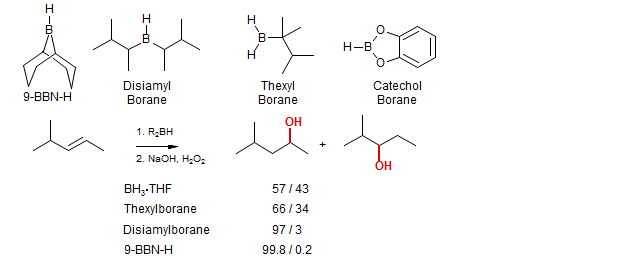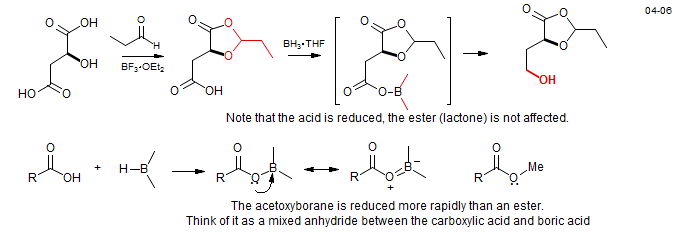Boron Hydrides
Zinc borohydride — a reducing agent with high potential,
Ranu, B. C. Synlett, 1993, 885.
Synthetic Applications of Zinc Borohydride,
Narasimhan, S.; Balakumar, R. Aldrichimica Acta 1998, 31, 19-26.
Sodium Borohydride
NaBH4 is the most commonly used mild (selective) hydride reducing agent. It reacts well with aldehydes, ketones, acid chlorides, anhydrides and imides, but reacts sluggishly or not at all with esters, lactones, acids, nitriles, amides, nitro compounds, alkenes, epoxides and alkynes. It is not very effective in SN2 reductions of halides and tosylates. NaBH4 is also commonly used in the reduction of organomercury compounds (from oxymercurations) and in the complete reduction of ozonides.

Waol A: Gao, X.; Nakadai, M.; Snider, B. Org. Lett. 2003, 5, 451

Luche Reduction
NaBH4 shows significant tendency to do 1,4 reductions of α,β-unsaturated ketones. This can be ameliorated by use of the Luche conditions: NaBH4/CeCl3 (Luche, J.-L. J. Am. Chem. Soc. 1978, 100, 2226-2227.)


Modified Borohydrides - Reductive Aminations
Sodium Cyanoborohydride — A Highly Selective Reducing Agent for Organic Functional Groups,
C. F. Lane, Synthesis 1975, 135.
Sodium cyanoborohydride: The substitution of one H by CN in NaBH4 leads to a great attenuation of the nucleophilicity of the remaining hydrides, to the extent that NaBH3CN reacts with ketones and aldehydes at a significant rate only at low pH (<4). Presumably only the protonated carbonyl compound is reduced. It does however, react with immonium salts formed in situ by reaction of ketones or aldehydes with amines under weakly acidic conditions, leading to reductive amination. Amine borane complexes (H3B·NMe3) have similar reactivity to cyanoborohydride, and can also be used for reductive aminations.
R. F. Borch, M. Bernstein, H. D. Durst, J. Am. Chem. Soc. 1971, 93, 2897.

Dendrobine: A. S. Kende, T. J. Bentley, R. A. Mader, D. Ridge, J. Am. Chem. Soc. 1974, 96, 4332.

Modified Borohydrides - SN2 Reactions
Lithium Triethylborohydride is a much more nucleophilic hydride donor than is LiBH4 due to the effect of the electron releasing alkyl groups. This reagent is especially useful for SN2 reductions of alkyl halides and sulfonates, although it can also be used as a selective reductant for ketones and aldehydes.

Poison Frog Alkaloid (-)-205B: Smith, A. B. III; Kim, D. S. Org. Lett. 2005, 7, 3247.

α-trans-Bergamotene: Larsen, Monti J. Am. Chem. Soc. 1977, 99, 8015

Modified Borohydrides - Triacetoxyborohydride
Sodium Borohydride in CarboxylicAcid Media: A Phenomenal Reduction System,
Gribble, G. W. Chem. Soc. Rev. 1998, 27, 395-404.
Stereoselective reduction of β-hydroxyketones to give anti 1,3-diols. Evans, DiMare J. Am. Chem. Soc. 1986, 108, 2476; J. Am. Chem. Soc. 1988, 110, 3560.


Adaline: Itoh, T.; Yamazaki, N.; Kibayashi, C. Org. Lett. 2002, 4, 2469. DOI

Modified Borohydrides - Steric Effects
Tri-sec-butylborohydrides (sold under the trade names L-Selectride and K-Selectride) show exceptional steric selectivity in the reduction of ketones and aldehydes. Brown J. Am. Chem. Soc. 1973, 95, 4101.


Conjugate Reduction: Tri-sec-butylborohydride reagents also show a strong tendency for conjugate reduction of enones (1,4- rather than 1,2-reduction). The enolates formed can be trapped with various electrophiles, if desired. Ganem J. Org. Chem. 1976, 41, 2194.

Capnellene: Crisp, G. T.; Scott, W. J.; Stille, J. K. J. Am. Chem. Soc. 1984, 106, 7500


Avrainvillamide: Herzon, S. B.; Myers, A. G J. Am. Chem. Soc. 2005, 127, 5342 DOI

Dihydroxanthatin: Evans, M. A.; Morken, J. P. Org. Lett. 2005, 7, 3371

Boranes - Alkene Hydroboration
The Lewis acidic boron results in a substantially different reactivity profile for boranes vs anionic borohydrides. Most important is the high reactivity of most boranes towards alkenes and alkynes, which are essentially unreactive towards borohydrides. There are a large number of borane reagents that have a variety of special properties for selective reductions. For run-of-the-mill hydroborations the THF (H3B·THF) or dimethyl sulfide (H3B·SMe2) complexes of borane are used.
Hydroboration: The most important reaction of boranes is alkene hydroboration (usually followed by oxidation to an alcohol with alkaline hydrogen peroxide or an amine oxide). The hydroboration is strictly a cis addition of H and B across the multiple bond, and shows a strong tendency for placement of the boron at the less substituted end of the double bond.
Nobel-Prize-winning chemistry
H. C. Brown, 1979
Punctatin A: Paquette, L. A.; Sugomura, T. J. Am. Chem. Soc. 1987, 109, 3017

Hydroboration of unhindered alkenes is faster than reduction of ketones. In the example below, hydroboration of the terminal alkene proceeded without significant reduction of either the ester or ketone. Quadrone: Danishefsky, S.; Vaughan, K.; Gadwood, R. C.; Tsuzuki, K. J. Am. Chem. Soc. 1981, 103, 4136.

However, in the examples below the double bond is more hindered, and selective hydroboration was not possible. In the first example, both the ketone and double bond were reduced. In the second example protection of the ketone was needed: formation of an ethylene ketal was unsuccessful, but the hydrazone worked.
Aromaticin: Majetich, G.; Song, J. S.; Leigh, A. J.; Condon, S. M. J. Org. Chem. 1993, 58, 1030.

Sativene, (±): McMurry, J.E. J. Am. Chem. Soc., 1968, 90, 6821.

For unusual steric selectivity 9-BBN-H, disiamylborane and thexyl borane are useful.

Chiral Boranes for Asymmetric Reductions. Asymmetric Hydroboration Using Diisopinocampheyl Borane: H. C. Brown, et al. JACS, 1985, 107, 2564.

Tylonolide Intermediate: S. Masamune et al. JACS, 1982, 104, 5523.

Boranes - Alkyne Hydroboration
Hydroboration of internal alkynes stops cleanly at the vinyl borane stage even with unhindered boranes. Terminal alkynes, on the other hand, usually give a poorly controlled mixture of mono and bis-hydroborated materials with H3B·THF (e.g. 1-hexyne gives mostly the 1,1-dihydroborated material). However, several substituted hindered boranes, such as HB(Cyclohexyl)2 (example below), catecholborane and 9-BBN-H will undergo selective mono-addition to form vinyl boranes, and these can be used in Suzuki coupling reactions, converted to vinyl halides, or protonated to give exclusively cis-alkenes. Ginkolide B: Corey, E. J.; Kang, M. C.; Desai, M. C.; Ghosh, A. K.; Houpis, I. N. J. Am. Chem. Soc. 1988, 110, 649-651.

Boranes - Selective Reduction of Carboxylic Acids
A very useful selectivity difference between boranes and borohydrides is that boranes will reduce carboxylic acids faster than they reduce carboxylic esters, whereas borohydrides and aluminohydrides show the opposite selectivity. This is because the acetoxy borane intermediate is an activated ester resulting from π-donation of acetoxy oxygen to boron (essentially a mixed anhydride between the carboxylate and a borinic acid). In the example below a carboxylic acid is reduced in the presence of a lactone. Lactones are usually better electrophiles than acyclic esters, and this one is additionally activated by the α-alkoxy substituent.
Brasilenyne: Denmark, S.; Yang, S. M. J. Am. Chem. Soc. 2004, 126, 12432.
